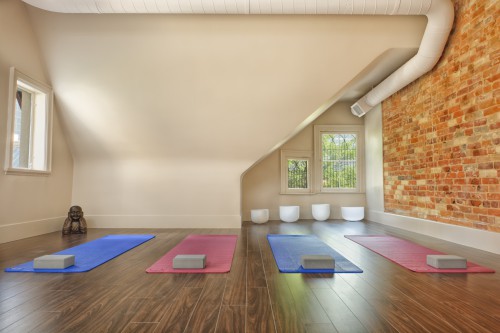Sound is all around us, inescapable. Sometimes jarring, sometimes serene.
According to psychotherapist Carmen Littlejohn at Helix, we can utilize the calming aspects of sound to improve our mental health. Helix has started incorporating Sound Therapy to their treatment options, which is often paired with acupuncture or moving meditation. By pairing these treatments with a live instrument ‘sound bath’, Littlejohn has seen clients attain a marked improvement in their overall well-being.

SDTC: How does sound therapy ease anxiety and depression?
CL: Sound is the first sense to develop fully in the womb, connecting us to the world. We are emotionally connected to sounds, whether it’s the pitter patter of rain, a thunderstorm, or the way a song makes us feel.
While psychotherapy addresses anxiety in the thoughts and mind, sound therapy addresses it in a different way. The instruments help light up different parts of the brain and each evokes different emotions. The instruments also vibrate in way that activate the right and left brain in a back and forth pattern called binaural frequency which is essential for healing and theta brain states (when in this meditative state, people can feel a sense of tranquility, like you are flying or floating). By entering a relaxed state, the client can process an experience and help to release old negative feelings that they have been holding onto.
How did you decide which instruments to use?
The instruments we use at Helix Healthcare Group are specifically tuned to interact in different ways with the human nervous system. Some of them calm anxiety whiles others lift depression. The crystal bowls create frequencies, which create activity in both hemispheres of the brain. The didgeridoo and flute are both wind instruments, and human breath has an authentic way of touching the listener, connecting deep with the soul.
The experience of a sound bath affects everyone differently, but the closer we are physically to the vibrations, the more they resonate within our bodies. When we are doing a sound bath we recommend that the client lies down on the floor with their head situated very close to the instruments for maximum impact.
How did you arrive upon which frequencies would be particularly soothing?
A 432Hz frequency resonates inside the body to help release emotional blockages or stuck energy, and expands our consciousness. On the other hand, listening to music tuned to the “disharmonic” 440Hz frequency can cause stress, negative behaviors and unstable emotions.
Sound Therapy uses the healing power of music and sound to create body awareness, insight, and relaxation. Using a variety of live musical instruments tuned to 432Hz, a ‘sound bath’ is designed to access parts of the brain that are not normally accessed through traditional talk therapy.

Are certain tones/instruments effective for some people but not others?
Yes, an instrument for one person may be grounding and soothing, whereas it will make another person agitated or angry. For example, a certain sound may remind someone of a negative experience in her life and tap into an old trauma. Since our sound therapists work in conjunction with our psychotherapists, the whole team helps the client process the experience they have in any given session, and therefore use the sound bath to access deeper unconscious material that has been causing problems in their life.
Are there certain sounds that can actually increase anxiety?
When a person is in an anxious, angry or stressed state they vibrate at a higher intensity. So if a sound therapist introduces a high vibrational frequency at the beginning of the session, it can aggravate these emotions.
Different instruments have different tones that resonate with different emotional states. Lower and long tones help to with grounding, middle tones work on a different emotional level, whereas higher tones are more uplifting. The sound therapist assesses the client before any session starts. But almost everyone, if they continue working with sound and in conjunction with a psychotherapist, will see the sessions improve and that the anxiety will decrease or go away completely. This will also correlate to decreasing the triggers for anxiety in their everyday lives.
Why did you introduce sound therapy to your therapy practice?
During a tough emotional time in his life, my husband was gifted a crystal bowl. When he played it and toned with it, it helped soothe his sadness. He figured this might help others too, so he tried it and low and behold, sound therapy entered our lives. After a particularly powerful sweat lodge in Los Angeles, I met a indigenous man that taught me to play the Native American flute in harmony to their tradition. My husband and I have been playing this soothing and amazing music ever since.
Are there ways we can use the principles behind sound therapy in our daily lives?
Definitely! We can incorporate sounds that make us happy and relaxed: this could include putting on a favourite song, humming a melody, listening to rain or the sound of the ocean. Sitting with a soothing song for just a few minutes first thing in the morning before we start getting ready can really shift the experience of our day. Once we identify the music or sound that puts us into a relaxed state, we can use that as a valuable trigger tool against stress.
For more information, or to inquire about treatments, visit Helix Healthcare Group.
Carmen Littlejohn is a Psychotherapist with a Master’s degree in Clinical and Somatic Psychology and a Master’s degree in Spiritual Psychology. She’s a certified member of the Canadian Counseling and Psychotherapy Association (CCC). Holding a Bachelor’s degree in Kinesiology and Physical Therapy, she worked for many years in the field of physical fitness, injury rehabilitation and neuromuscular therapy. She weaves together an extensive knowledge of neurobiology, psychology and spirituality to help her clients heal the connections between the body, mind and spirit.



 Follow Us On Instagram
Follow Us On Instagram
